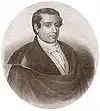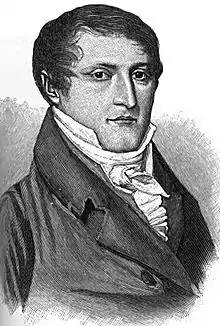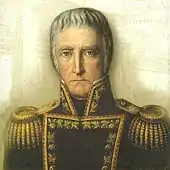Primera Junta
The Primera Junta (English: First Junta) or Junta Provisional Gubernativa de las Provincias del Río de la Plata (Provisional Governing Junta of the Provinces of the Río de la Plata),[1] is the most common name given to the first government of what would eventually become Argentina. It was formed on 25 May 1810, as a result of the events of the May Revolution. The Junta initially only had representatives from Buenos Aires. When it was expanded, as expected, with the addition of representatives from the other cities of the Viceroyalty of the Río de la Plata, it became popularly known instead as the Junta Grande (Grand Junta) or Junta Provisional Gubernativa de Buenos Aires.[2] The Junta operated at El Fuerte (the fort, where the modern Casa Rosada stands), which had been used since 1776 as a residence by the viceroys.
Primera Junta Junta Provisional Gubernativa de las Provincias del Río de la Plata | |
|---|---|
 | |
| Type | |
| Type | |
| History | |
| Established | 25 May 1810 (May Revolution) |
| Disbanded | 18 December 1810 |
| Succeeded by | Junta Grande |
| Leadership | |
President | |
Voting members | |
Secretaries | |
| Elections | |
Last election | May Revolution |
| Meeting place | |
| Fort of Buenos Aires | |
Creation
This Junta—officially named the Junta Provisional Gubernativa de las Provincias del Río de la Plata a nombre del Señor Don Fernando VII (Provisional Governing Junta of the Provinces of Río de la Plata in the Name of Lord Don Ferdinand VII)—allegedly meant to govern in the name of the King of Spain, while he was imprisoned by Napoleon Bonaparte. Juntas were a form of transitional or emergency government that emerged during the Napoleonic invasion in Spanish cities that had not succumbed to the French and which attempted to maintain Spanish sovereignty. The most important for Spanish America was the Junta of Seville, which claimed sovereignty over overseas possessions, given the fact that the province of Seville historically had enjoyed exclusive rights to the American trade. Its claims had been rejected by Spanish Americans, and its authority was quickly superseded by a Supreme Central Junta of Spain, which included American representation.
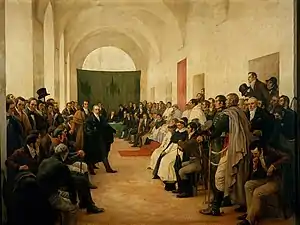
When the Supreme Central Junta abolished itself in 1810, the politically active inhabitants of Buenos Aires saw no better moment than this to establish a local government.[3] They had been influenced by the recent democratic and republican philosophical wave, and were also concerned about the commercial monopoly exerted by the Spanish crown, which was suffocating the local economy. Historically Buenos Aires province had partially mitigated this problem through contraband. Local politicians, such as former council member and legal advisor to the viceroy, Juan José Castelli, who wanted a change towards self-government and free commerce, cited traditional Spanish political theory and argued that since the King had been imprisoned, sovereignty had returned to the people.[4]
The people were to assume the government until the King returned, just as the subjects in Spain had done two years earlier with the establishment of juntas. The viceroy and his supporters countered that the colonies belonged to Spain and did not have a political relationship with the King only. Therefore, they should follow any government body established in Spain as the legal authority, namely the Supreme Central Junta of Spain and its successor, the Council of Regency.
The meeting of a Buenos Aires cabildo abierto (an extraordinary meeting of the municipal council with the assistance of over 200 notables from the government, the church, guilds and other corporations) on 22 May 1810, came under strong pressure from the militias and a crowd that formed in front of the cabildo hall on the Plaza Mayor (today the Plaza de Mayo), up to 25 May. The crowd favored the stance of the local politicians, and the cabildo ended up creating the Primera Junta, the first form of local government in the territory that would later become Argentina. Spain would never recover its dominion over that territory. From the very beginning of the new government, two factions manifested their differences, a more radical one, whose visible leader was the Junta's Secretary, Mariano Moreno, and the conservative wing that supported the Junta's president, Cornelio Saavedra.
In general the principles of the May Revolution were popular sovereignty, the principle of representation and federalization, division of powers, the maintenance of the mandates, and publication of the government's actions
Personnel
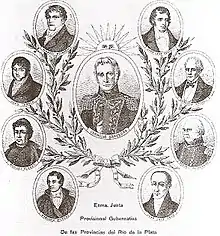
President
Secretaries:
Committee member
Duration and transformation
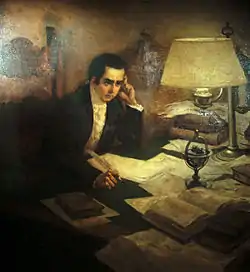
Despite the replacement of viceroy Baltasar Hidalgo de Cisneros, the Royal Audience and the Cabildo stood with the authorities that existed before the revolution, who opposed the Junta since its first day. The Audience refused at first to swear allegiance to the Junta, and when they finally did, prosecutor Caspe did so with clear gestures of contempt. Caspe would later be ambushed near his home, in retaliation for this.[5] The Cabildo imposed a time limit on the Junta: if the General Congress was not formed in six months, the Cabildo would reassume government. The Junta answered the same day, rejecting such requirements. The Audience then requested that the Junta submitted to the Council of Regency, but the Junta refused, on the grounds that Cisneros did not so submit and the Audience did not request him to. The Audience itself swore allegiance to the Council shortly after, and they were all banished in response. Together with the ex-viceroy Cisneros, they were forced to take the ship Dart that left them at the Canary Islands; the exceptions were Márquez del Plata, who was at the Banda Oriental at the time, and the octogenarian Lucas Muñoz Cubero.[6]
From the early days of the Primera Junta there was a strong rivalry between Saavedra and Moreno. According to Ignacio Núñez, the Morenists accused Saavedra of plotting to restore the tyranny of the viceroys in his office, while the Saavedrists accused Moreno of usurping government roles that were not intended for him.[7] Matheu would also point in his memories that the Morenists were upset because they perceived that Saavedra enjoyed receiving honors and distinctions that they had chosen to avoid.[7]
The Junta was received with mixed reactions from the other cities of the viceroyalty. Santa Fe, Entre Ríos, Misiones, Corrientes and Mendoza supported the change, others did not. Upper Peru, which greatly benefited from the system of mita to exploit the mines in Potosi, supported the absolutist system for a long time. Javier de Elío in Montevideo denied recognition to the Junta. Paraguay was torn between supporters of either side, but royalists prevailed. However, the most immediate danger to the Junta came from Cordoba, where Santiago de Liniers came out of his retirement and started to organize an army to lead a counter-revolution against Buenos Aires. The Junta ordered Ortiz de Ocampo to stand against those counter-revolutionaries and bring the leaders as prisoners to Buenos Aires. A later ruling requested to execute them instead , but after defeating Liniers, Ortiz de Ocampo decided to ignore the latter and instead to follow the first ruling. The Junta removed Ocampo from his duty for this act of disobedience, and replaced him with Juan José Castelli. Castelli ordered the execution of the counter-revolutionaries by August 26, with the exception of the priest Orellana. By this time, Mariano Moreno was popularly regarded as the leader of the revolution, whose resolution permitted the radical changes to the absolutist system that the Junta had managed so far.[8]
There's some controversy among historians about the authenticity of the Operations plan, a secret document attributed to Mariano Moreno, that set a harsh government policy in the fields of economics, politics and international relations.
Military authorities, fearing the loss of power by Saavedra, pressured the Junta to control Moreno. Moreno, on the other hand, succeeded in getting the approval of decrees that limited Saavedra and others. By December 1810 tensions had reached a peak. Saavedra got the support of deputies sent by the interior provinces that had not yet been allowed to join the Junta. With this backing, Saavedra gave Moreno his most serious political setback: he forced Moreno to present his resignation on 18 December. With this resignation, the integration of the deputies from the other provinces to the Junta became possible.
Created on 25 May 1810, the Primera Junta was thus transformed on 18 December of the same year into the new Junta Grande by the introduction of representatives from other provinces of Río de la Plata.
Foreign policy
The Primera Junta was concerned with the risk of Portuguese expansion towards La Plata, either directly or through the Carlotist project. The diplomacy in Spain attempted to prevent the dispatch of a punitive army, limiting the armed conflicts to the royalists in Paraguay, Upper Peru and the Banda Oriental. The Junta declared itself a natural ally of any city that revolted against the royalists; either those that did so in support of the May Revolution or those who revolted on their own (Chile and Paraguay shortly after Manuel Belgrano's defeat).[9]
Britain, allied with Spain in the Napoleonic Wars, stayed neutral in the conflicts between patriots and royalists. Nevertheless, the British policy towards the conflict was to favour British trade as long as it did not conflict with the neutral policy.[9]
Bibliography
- Abad de Santillán, Diego. Historia Argentina (in Spanish). Buenos Aires: TEA (Tipográfica Editora Argentina).
- Halperín-Donghi, Tulio. Politics, Economics, and Society in Argentina in the Revolutionary Period. Cambridge, Cambridge University Press, 1975. ISBN 978-0-521-20493-4
- Galasso, Norberto (2004). Mariano Moreno – El sabiecito del sur. Buenos Aires: Colihue. pp. 6–7. ISBN 950-581-799-1.
References
- Casajús (2012). España y América en el Bicentenario de las Independencias. p. 35.
- Casal, Juan Manuel (2012). Paraguay en la historia, la literatura y la memoria.
- Saavedra, Cornelio (2009). Memoria autógrafa. Buenos Aires: Editorial del Nuevo Extremo. p. 59. ISBN 978-987-609-171-8.
Spanish: A la verdad, quién era en aquel tiempo el que no juzgase que Napoleón triunfaría y realizaría sus planes con la España? Esto era lo que yo esperaba muy en breve, la oportunidad o tiempo que creía conveniente para dar el grito de libertad en estas partes. Esta era la breva que decía era útil esperar que madurase.
At the hour of truth, who was there in that time that did not consider that Napoleon would triumph and realize his plans for Spain? This was what I expected soon, the chance or time I deemed convenient to give the freedom cry in those parts. This was the fig I said it was useful to wait to ripen. - Pigna, Felipe (2007). "La Revolución de Mayo". Los mitos de la historia argentina (in Spanish) (26 ed.). Argentina: Grupo Editorial Norma. p. 236. ISBN 978-987-545-149-0.
Spanish: Nadie ha podido reputar por delincuente a la nación entera, ni a los individuos que han abierto sus opiniones políticas. Si el derecho de conquista pertenece, por origen, al país conquistador, justo sería que la España comenzase por darle la razón al reverendo obispo abandonando la resistencia que hace a los franceses y sometiéndose, por los mismos principios con que se pretende que los americanos se sometan a las aldeas de Pontevedra. La razón y la regla tienen que ser iguales para todos. Aquí no hay conquistados ni conquistadores, aquí no hay sino españoles. Los españoles de España han perdido su tierra. Los españoles de América tratan de salvar la suya. Los de España que se entiendan allá como puedan y que no se preocupen, los americanos sabemos lo que queremos y adónde vamos. Por lo tanto propongo que se vote: que se subrogue otra autoridad a la del virrey que dependerá de la metrópoli si ésta se salva de los franceses, que será independiente si España queda subyugada.
- Galasso, Norberto, pp. 6–7
- Galasso, Norberto, pp. 11
- Galasso, Norberto, pp. 12
- Galasso, Norberto, pp. 22
- Abad de Santillán, p. 571





